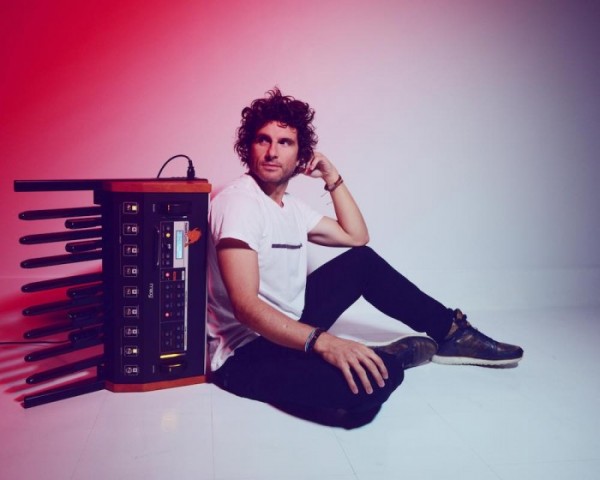Oct 28, 2025 10:47 AM
In Memoriam: Jack DeJohnette, 1942–2025
Jack DeJohnette, a bold and resourceful drummer and NEA Jazz Master who forged a unique vocabulary on the kit over his…

Pianist Romain Collin learned to play synth bass before recording Tiny Lights.
(Photo: Shervin Lainez)Romain Collin often recalls an enduring maxim from Terence Blanchard: “All complicated things are created from an interaction among simple things.”
Those words locked in his mind, the pianist set out to create a mixed-media release reflective of a journey toward transcendence. In realizing Tiny Lights, Collin embarked on his own short, but vivid, journey toward self-discovery, issuing the record online in three separate installments representing a beginning, middle and end, before the physical album release.
“The story [describes] a process of self-growth in as fearless and committed a way as possible,” he said. “[Writing] music is the same.”
But Collin soon recognized the limits of his existing musical expression. “I discovered that the piano trio, as I had approached it so far, was not a setup that enabled me to express the sounds that I needed,” he said.
Knowing he wanted a trio recording with drums and guitar, Collin called guitarist Matthew Stevens and drummer Obed Calvaire. Contributions from the Prague Philharmonic Orchestra and composer Kazuma Jinnouchi helped texturize the narrative, while Collin attempted to master an instrument he was unfamiliar with: the Moog Taurus synth bass.
The bandleader composed the entire record—including a number of ostinatos shaping the musical narrative—without having ever touched the Taurus. “When I write ostinatos, the idea is never to be repetitive,” he said. “It’s the undercurrent, the driving force.” And Collin soon discovered the collateral impact of integrating a new sound and skill set into his performance. “When I first started playing the synth bass, it made me play the piano in a slightly more organic, less deliberate way,” he said.
What Collin found was freeing. He encountered relief from the pressure of his critical mind, and experienced renewed intention: “You have to be more accepting of what you play, because it’s almost like something that needed to be played.”
An accomplished film composer, Collin imbued Tiny Lights with layers of visual evocation and stimuli. “Every sound has a texture and a color in my brain,” he said. “In this project, I’ve allowed myself to pay attention to it more.”
For the record’s accompanying film series and recorded live performances that Collin posted to Instagram, he collaborated with Spain-based production house Neutrø. But back in the States, Collin met up with filmmaker Matthew Palmer, sharing with him the project idea for Tiny Lights. “He said, ‘Man, I really wanna put visuals to this,’” Collin recalled. “So, I sent him the music.”
Despite offering the signposts of a story, Collin relinquished creative control of the visual narrative to Palmer, who produced the video for “Tiny Lights That Move And Speak.”
“He came back to me and said, ‘This is what I’m seeing,’” Collin said, “and that’s exactly what I was seeing as well.”
The visual manifestation of Tiny Lights served another purpose for Collin, who came up with the MTV generation: recapturing mainstream audio-visual relationships that have been lost in the digital era. “Before MP3s and downloads, every musician was a multimedia artist,” he said. “They all had dope artwork—a booklet that you can lose yourself in, lyrics that were laid out graphically, pictures—it really gave the artists a chance to present a world bigger than just the music.”
For Tiny Lights, the allure of a mixed-media narrative unfolding in the age of insta-culture is what inspired Collin to release the album in three parts. “I’m hoping that that, in and of itself, tells a story,” he said. “If something inhabits you, day and night, how can you not allow it to transpire? You can’t escape that process. And you shouldn’t try.” DB

Jack DeJohnette boasted a musical resume that was as long as it was fearsome.
Oct 28, 2025 10:47 AM
Jack DeJohnette, a bold and resourceful drummer and NEA Jazz Master who forged a unique vocabulary on the kit over his…

D’Angelo achieved commercial and critical success experimenting with a fusion of jazz, funk, soul, R&B and hip-hop.
Oct 14, 2025 1:47 PM
D’Angelo, a Grammy-winning R&B and neo-soul singer, guitarist and pianist who exerted a profound influence on 21st…

To see the complete list of nominations for the 2026 Grammy Awards, go to grammy.com.
Nov 11, 2025 12:35 PM
The nominations for the 2026 Grammy Awards are in, with plenty to smile about for the worlds of jazz, blues and beyond.…

Drummond was cherished by generations of mainstream jazz listeners and bandleaders for his authoritative tonal presence, a defining quality of his style most apparent when he played his instrument unamplified.
Nov 4, 2025 11:39 AM
Ray Drummond, a first-call bassist who appeared on hundreds of albums as a sideman for some of the top names in jazz…

Jim McNeely’s singular body of work had a profound and lasting influence on many of today’s top jazz composers in the U.S. and in Europe.
Oct 7, 2025 3:40 PM
Pianist Jim McNeely, one of the most distinguished large ensemble jazz composers of his generation, died Sept. 26 at…





